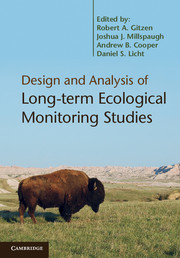Book contents
- Frontmatter
- Contents
- List of contributors
- Foreword: Ecology, management, and monitoring
- Preface
- Acknowledgments
- Abbreviations
- Section I Overview
- 1 Ecological monitoring
- 2 An overview of statistical considerations in long-term monitoring
- 3 Monitoring that matters
- 4 Maximizing the utility of monitoring to the adaptive management of natural resources
- Section II Survey design
- Section III Data analysis
- Section IV Advanced issues and applications
- Section V Conclusion
- References
- Index
- Plate Section
2 - An overview of statistical considerations in long-term monitoring
Published online by Cambridge University Press: 05 July 2012
- Frontmatter
- Contents
- List of contributors
- Foreword: Ecology, management, and monitoring
- Preface
- Acknowledgments
- Abbreviations
- Section I Overview
- 1 Ecological monitoring
- 2 An overview of statistical considerations in long-term monitoring
- 3 Monitoring that matters
- 4 Maximizing the utility of monitoring to the adaptive management of natural resources
- Section II Survey design
- Section III Data analysis
- Section IV Advanced issues and applications
- Section V Conclusion
- References
- Index
- Plate Section
Summary
Management decisions all too often are based on data of unknown reliability – that is, from research conducted using biased methods, low sample sizes, and inappropriate analyses.…The general dearth of monitoring, validation, and adaptive management research forces a vicious cycle. This does not need to – and should not – persist.
(Morrison et al. 2006: xix)Introduction
Developing a monitoring program requires a chain of decisions, many complex, about a variety of issues. These decisions deal with questions ranging from policy and management (“What information is required to decide among the feasible actions?”) to the science of the system under study (“What is the best indicator of the ecological process of interest, and what is the best measurement protocol for that attribute?”) to purely statistical (“How much effort will it take to estimate a parameter with a precision of ±10% of its true value?”). This variety of challenging questions implicitly encourages compartmentalization and isolation in decision making. However, this compartmentalized approach can lead to suboptimal and even counterproductive decisions. Instead, a “whole-problem” perspective helps us see that all of the necessary decisions interact to influence the quality and cost of the monitoring program's ultimate product, information (Box 2.1).
A whole-problem perspective reveals that statistical considerations permeate the monitoring process. Information quality, a key measure of a monitoring program’s effectiveness, inherently entails consideration of the statistical concepts of bias and uncertainty (Box 2.2). Bias and uncertainty are controlled and accounted for through statistical methods of survey design, measurement, and analysis. Most importantly, effectively incorporating these statistical methods into the broader monitoring program requires statistical thinking to see how each source of bias and variability ultimately impacts information quality and cost and to identify where to allocate resources among the many program components to most efficiently improve information quality (Hooke 1980, Snee 1990, Chance 2002, Hoerl and Snee 2010).
- Type
- Chapter
- Information
- Publisher: Cambridge University PressPrint publication year: 2012
- 19
- Cited by

